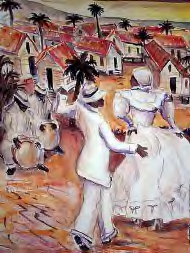|

La Bomba
The bomba is a uniquely Puerto Rican musical genre for dance. Although critics are uncertain about the exact origin of the bomba, it is generally agreed that it is derived from West Africa, through the importation of slaves to Puerto Rico from that region. Some have said that it first developed at the end of the 17th century in Loiza, a Puerto Rican town with a strong African presence. The bomba flourished wherever the West African slaves and their descendants lived and worked. In Puerto Rico, this was typically on the colonial plantations that were common along the coastal plains.

These African communities in Puerto Rico were forbidden to worship their ancient African gods so they instead fused their customs onto the workship of St James. During festivals to honor the Christian St James, bomba music was played and the traditional mask was worn. The mask, called "vejigante" in Spanish, was supposed to scare away evil spirits and pirates.

The bomba is basically accompaniment for dancers. There are several different styles of bomba which differ in their rhythms. Some bombas have a name that reflects their African origin. Names such as babú, belén, cunyá, yubá and others. Other bomba styles are named for the type of dance it is associated with, such as leró, which is a French derivative meaning "rose", in reference to the formation of the dancers that symbolized a rose.

The bomba emerged as a very important expression to the system of slavery and a form of spiritual strength. It's a family of rhythms and dances referred to by their names... Bomba is more like an event: it involves singing, dancing and music," says Héctor Lugo, singer and percussionist of San Francisco-based traditional bomba and plena band, Los Pleneros de la 24. Bomba dances were typical during important social or community events.

Typically, a bomba starts with a female solo voice called "laina" who sings a phrase evoking a primitive call. The chorus makes an antiphonal response to this call supported by the musicians who provide the 2/4 or 6/8 rhythm with various percussion instruments. Meanwhile, the dancers proceed with their movements, in pairs and without contact. The vocals rely on the melody and harmony is not used.

Dancers are essential to bomba. Dancers take turns challenging the drums, creating a dialog with their movements that the solo drummer answers in a call-and-response pattern with a lead singer and a chorus. The words are traditional and improvisatory, often revolving around events in the community.

An excellent example is this song, entitled Yenyeré, from the "Raices" album produced by the Banco Popular in 2001. In an elaborate sequence, one of the dancers will typically approach the musicians and dance a series of fast steps called "floretea piquetes" to which a "tambor" would respond, establishing a "controversia" by way of this call and response... a rhythmic dialogue that is at the heart of the bomba genre. Other dancers, in turn, do likewise.

The instruments used in the bomba are are tambors; typically the low-pitched buleador providing supporting rhythm and the high-pitched subidor dialoging with the dancers and which provides the foundation of the rhythm Added to these are the sticks or "palitos", called "cuá" or sometimes fuá, which are sticks struck on a resonant surface, and one maraca (not a pair) often played by one of the singers, usually a female.




|
|